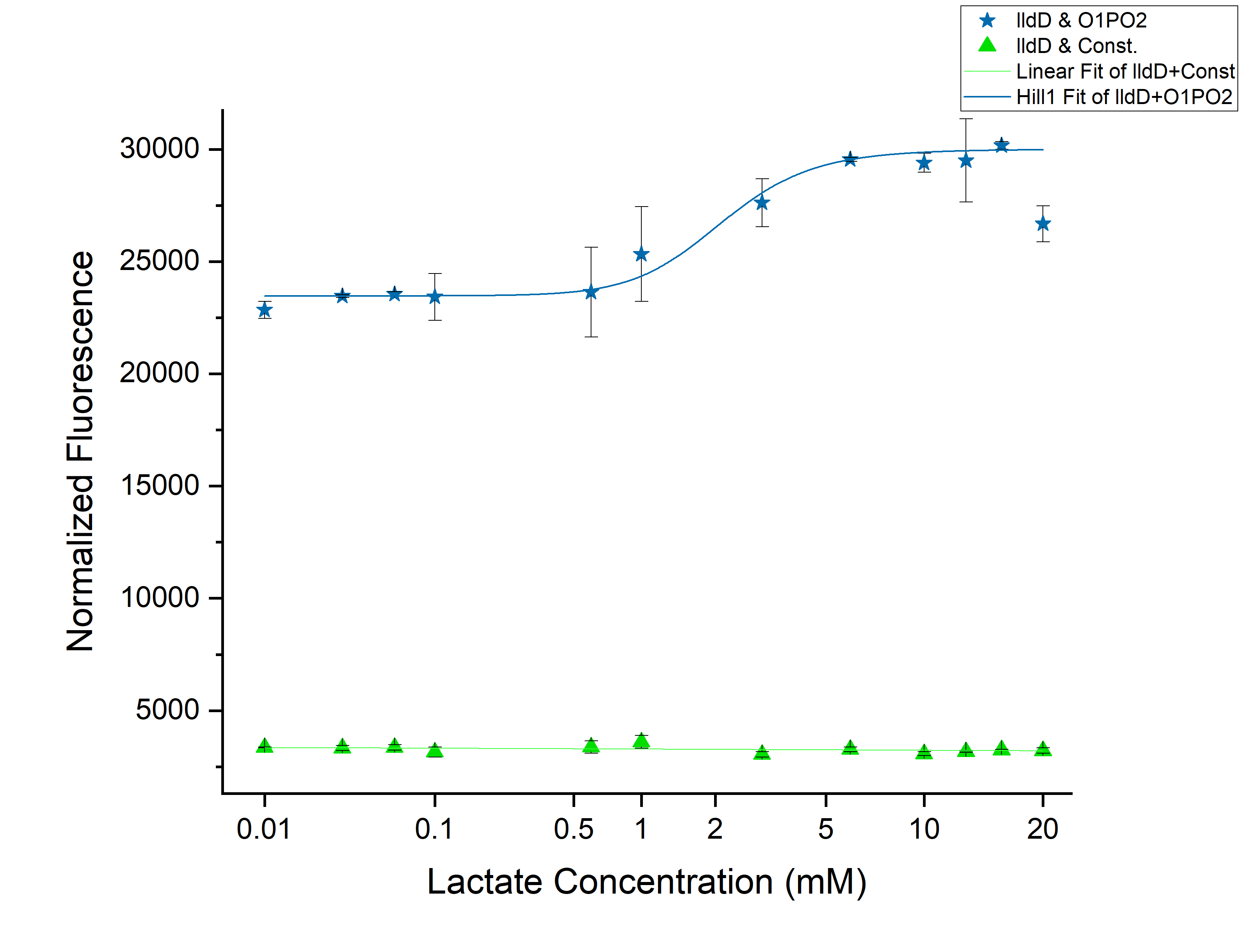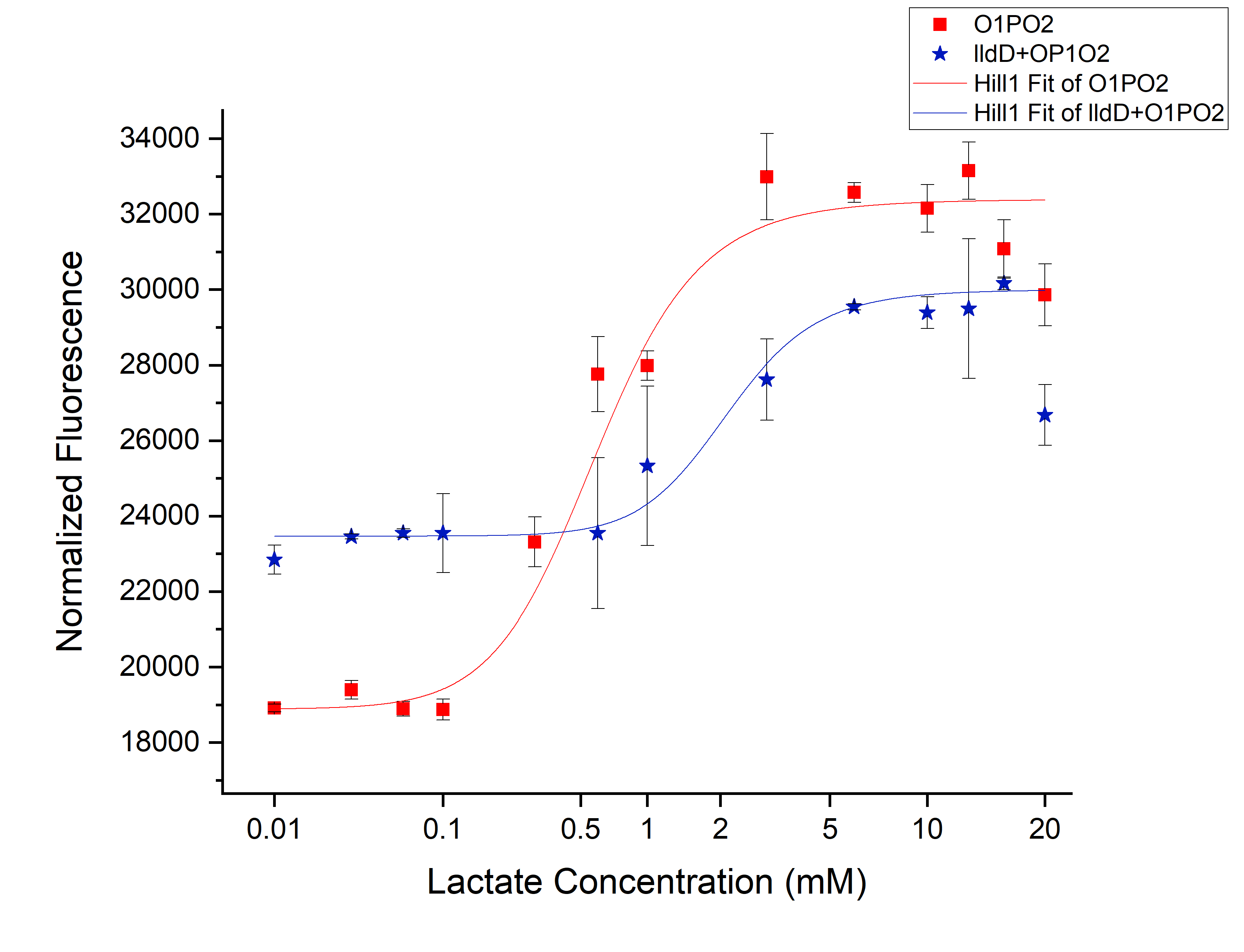Difference between revisions of "Part:BBa K3110007"
| Line 28: | Line 28: | ||
| − | From the above graph it's clear that the construct lldRO1-J23117-lldRO2 Strong RBS sfGFP ([[Part:BBa_K3110040]]) gives a sigmoidal pattern for detection of lactate with a threshold of around 0.45 mM. However, this is | + | From the above graph it's clear that the construct lldRO1-J23117-lldRO2 Strong RBS sfGFP ([[Part:BBa_K3110040]]) gives a sigmoidal pattern for detection of lactate with a threshold of around 0.45 mM. However, this is not an appropriate threshold since the construct might fail to distinguish Cancerous vs Non-cancerous microenvironments, both of which have lactate concentration than 0.45mM. Hence we have intended to use this construct in combination with our library of four gene constructs: lldD, lldP+lldD, lldR+lldD and lldP+lldR+lldD under promoter and RBS of different strengths. |
We hypothesized that, if we can increase the amount of Lactate Dehydrogenase inside the cell, it will cleave some amount of Lactate. So, the surge in sfGFP expression should be seen in a higher concentration of lactate induction. | We hypothesized that, if we can increase the amount of Lactate Dehydrogenase inside the cell, it will cleave some amount of Lactate. So, the surge in sfGFP expression should be seen in a higher concentration of lactate induction. | ||
| Line 47: | Line 47: | ||
[[File:T--IISER Tiruapti--lldD.png|thumb|center|700px|Figure 2. Relative Expression of sfGFP under the control of lldRO1-J23117-lldRO2([[Part:BBa_K1847008]])-strong RBS and Constitutive Promoter-strong RBS along with Medium Promoter-Strong RBS-lldD.]] | [[File:T--IISER Tiruapti--lldD.png|thumb|center|700px|Figure 2. Relative Expression of sfGFP under the control of lldRO1-J23117-lldRO2([[Part:BBa_K1847008]])-strong RBS and Constitutive Promoter-strong RBS along with Medium Promoter-Strong RBS-lldD.]] | ||
| − | From the above graph, | + | From the above graph, we observed an increase in threshold to 2 mM as we expected. Although this might not be able to differentiate cancer from non-cancerous cells. However, an increase of threshold suggests that our idea of using lldD as the modulator will work. To clearly understand the effect of ectopic lldD on O1PO2, we plotted the graphs for only O1PO2-Strong-RBS-sfGFP and O1PO2-Strong-RBS-sfGFP along with lldD together. |
<h3>Comparison between only O1PO2 and O1PO2 along with lldD</h3> | <h3>Comparison between only O1PO2 and O1PO2 along with lldD</h3> | ||
| Line 53: | Line 53: | ||
[[File:T--IISER Tirupati--compare.png|thumb|center|700px|Figure 3. Relative Expression of sfGFP under the control of only lldRO1-J23117-lldRO2([[Part:BBa_K1847008]])-strong RBS and lldRO1-J23117-lldRO2-strong RBS along with Medium Promoter-Strong RBS-lldD ([[Part:BBa_K3110007]]).]] | [[File:T--IISER Tirupati--compare.png|thumb|center|700px|Figure 3. Relative Expression of sfGFP under the control of only lldRO1-J23117-lldRO2([[Part:BBa_K1847008]])-strong RBS and lldRO1-J23117-lldRO2-strong RBS along with Medium Promoter-Strong RBS-lldD ([[Part:BBa_K3110007]]).]] | ||
| − | From this picture | + | From this picture, we can clearly see an increase in threshold from 0.45 mM (without lldD) to 2 mM (with lldD) as we expected. |
Another, major drawback that we observed from this was a decrease in sensitivity i.e. even at sub-threshold lactate levels, the fluorescence observed in the presence of lldD was high. Not only this, at the aforementioned threshold levels, the intensity was lower than in the case without lldD. This could be rectified by using lldP and lldR along with lldD.</p> | Another, major drawback that we observed from this was a decrease in sensitivity i.e. even at sub-threshold lactate levels, the fluorescence observed in the presence of lldD was high. Not only this, at the aforementioned threshold levels, the intensity was lower than in the case without lldD. This could be rectified by using lldP and lldR along with lldD.</p> | ||
Revision as of 16:17, 21 October 2019
Medium Promoter Strong RBS lldD
This construct has L-Lactate Dehydrogenase (lldD) under the control of a medium promoter and a strong RBS.
Sequence and Features
- 10COMPATIBLE WITH RFC[10]
- 12INCOMPATIBLE WITH RFC[12]Illegal NheI site found at 7
Illegal NheI site found at 30 - 21COMPATIBLE WITH RFC[21]
- 23COMPATIBLE WITH RFC[23]
- 25INCOMPATIBLE WITH RFC[25]Illegal NgoMIV site found at 1202
- 1000INCOMPATIBLE WITH RFC[1000]Illegal BsaI site found at 639
Usage and Biology
lldD cleaves L-lactate to pyruvate. Our intention of using this part is to have control over the detection threshold of L-Lactate by the lldPRD regulatory region. We have also designed other parts which produce various higher and lower concentrations of lldD by varying the strength of the promoter and RBS controlling its production.
Characterization of the Part
First we chose only lldRO1-J23117-lldRO2 Strong RBS sfGFP to distinguish between cancerous and non-cancerous micro-environments.

From the above graph it's clear that the construct lldRO1-J23117-lldRO2 Strong RBS sfGFP (Part:BBa_K3110040) gives a sigmoidal pattern for detection of lactate with a threshold of around 0.45 mM. However, this is not an appropriate threshold since the construct might fail to distinguish Cancerous vs Non-cancerous microenvironments, both of which have lactate concentration than 0.45mM. Hence we have intended to use this construct in combination with our library of four gene constructs: lldD, lldP+lldD, lldR+lldD and lldP+lldR+lldD under promoter and RBS of different strengths.
We hypothesized that, if we can increase the amount of Lactate Dehydrogenase inside the cell, it will cleave some amount of Lactate. So, the surge in sfGFP expression should be seen in a higher concentration of lactate induction.
Genetic Design for the Characterization
So, we designed the following gene construct to produce more LldD (L-Lactate dehydrogenase) in a different plasmid (pSB3K3): <bold>Medium Promoter-Strong RBS-lldD-Terminator</bold> We used medium promoter and cloned into a low copy number plasmid so that the amount of lldD inside the cell shouldn’t be too high to cleave all the lactate inside the cell and there is no lactate left inside the cell to induce O1PO2. Also, pSB3K3 and pSB1C3 are compatible plasmids and hence can be co-transformed. Then we co-transformed the 3 constructs in BL21(DE3) in 2 different combinations:
- Medium P-Strong RBS-lldD (in pSB3K3) + O1PO2-Strong RBS-sfGFP (in pSB1C3)
- Medium P-Strong RBS-lldD (in pSB3K3) + P-Strong RBS-sfGFP (in pSB1C3)
Results

From the above graph, we observed an increase in threshold to 2 mM as we expected. Although this might not be able to differentiate cancer from non-cancerous cells. However, an increase of threshold suggests that our idea of using lldD as the modulator will work. To clearly understand the effect of ectopic lldD on O1PO2, we plotted the graphs for only O1PO2-Strong-RBS-sfGFP and O1PO2-Strong-RBS-sfGFP along with lldD together.
Comparison between only O1PO2 and O1PO2 along with lldD

From this picture, we can clearly see an increase in threshold from 0.45 mM (without lldD) to 2 mM (with lldD) as we expected. Another, major drawback that we observed from this was a decrease in sensitivity i.e. even at sub-threshold lactate levels, the fluorescence observed in the presence of lldD was high. Not only this, at the aforementioned threshold levels, the intensity was lower than in the case without lldD. This could be rectified by using lldP and lldR along with lldD.</p>
